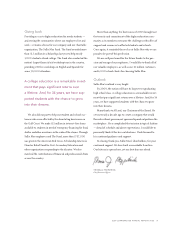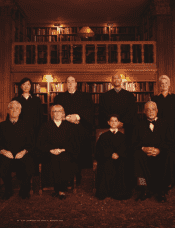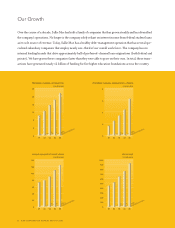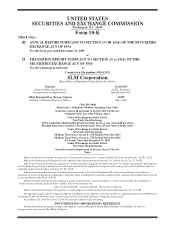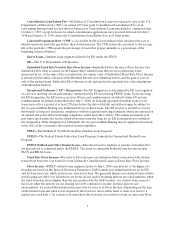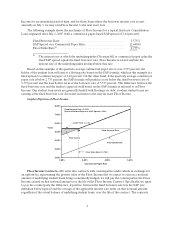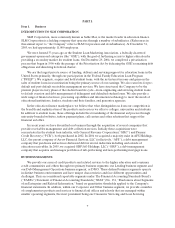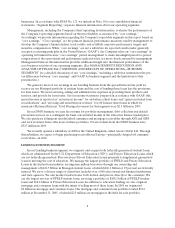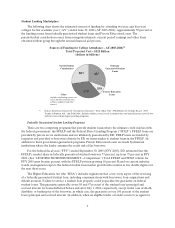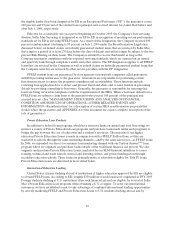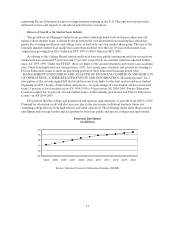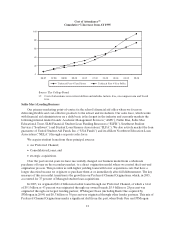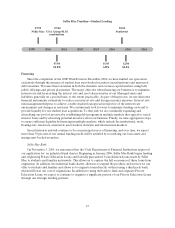Sallie Mae 2005 Annual Report Download - page 15
Download and view the complete annual report
Please find page 15 of the 2005 Sallie Mae annual report below. You can navigate through the pages in the report by either clicking on the pages listed below, or by using the keyword search tool below to find specific information within the annual report.5
generally do not extend over the life of the underlying student loans. This contract effectively locks in the
amount of Floor Income we will earn over the period of the contract. Floor Income Contracts are not
considered effective hedges under Statement of Financial Accounting Standards (“SFAS”) No. 133,
“Accounting for Derivative Instruments and Hedging Activities,” and each quarter we must record the
change in fair value of these contracts through income.
GSE—The Student Loan Marketing Association was a federally chartered government-sponsored
enterprise and wholly owned subsidiary of SLM Corporation that was dissolved under the terms of the
Privatization Act (see definition below) on December 29, 2004.
HEA—The Higher Education Act of 1965, as amended.
Managed Basis—We generally analyze the performance of our student loan portfolio on a Managed
Basis, under which we view both on-balance sheet student loans and off-balance sheet student loans owned
by the securitization trusts as a single portfolio, and the related on-balance sheet financings are combined
with off-balance sheet debt. When the term Managed is capitalized in this document, it is referring to
Managed Basis.
Offset Fee—We were required to pay to ED an annual 30 basis point Offset Fee on the outstanding
balance of Stafford and PLUS student loans purchased and held by the GSE after August 10, 1993. The fee
did not apply to student loans sold to securitized trusts or to loans held outside of the GSE. This fee no
longer applies, as the GSE was dissolved under the terms of the Privatization Act on December 29, 2004.
Preferred Channel Originations—Preferred Channel Originations are comprised of: 1) student loans
that are originated by lenders with forward purchase commitment agreements with Sallie Mae and are
committed for sale to Sallie Mae, such that we either own them from inception or acquire them soon after
origination, and 2) loans that are originated by internally marketed Sallie Mae brands.
Preferred Lender List—To streamline the student loan process, most higher education institutions
select a small number of lenders to recommend to their students and parents. This recommended list is
referred to as the Preferred Lender List.
Private Education Loans—Education loans to students or parents of students that are not guaranteed
or reinsured under the FFELP or any other federal student loan program. Private Education Loans
include loans for traditional higher education, undergraduate and graduate degrees, and for alternative
education, such as career training, private kindergarten through secondary education schools and tutorial
schools. Traditional higher education loans have repayment terms similar to FFELP loans, whereby
repayments begin after the borrower leaves school. Repayment for alternative education or career training
loans generally begins immediately.
Privatization Act—The Student Loan Marketing Association Reorganization Act of 1996.
Reauthorization Legislation—The Higher Education Reconciliation Act of 2005, which reauthorized
the student loan programs provisions of the HEA and generally becomes effective as of July 1, 2006. See
“MANAGEMENT’S DISCUSSION AND ANALYSIS OF FINANCIAL CONDITION AND RESULTS
OF OPERATIONS—OTHER RELATED EVENTS AND INFORMATION—Reauthorization.”
Residual Interest—When we securitize student loans, we retain the right to receive cash flows from
the student loans sold to trusts we sponsor in excess of amounts needed to pay servicing, derivative costs (if
any), other fees, and the principal and interest on the bonds backed by the student loans. The Residual
Interest (which may also include reserve and other cash accounts), is the present value of these future
expected cash flows, which includes the present value of Embedded Fixed Rate Floor Income described
above. We value the Residual Interest at the time of sale of the student loans to the trust and at the end of
each subsequent quarter.


